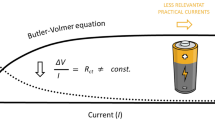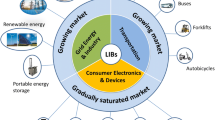Abstract
Electro-chemical impedance spectroscopy is widely used to analyze electro-chemical systems. Most attention is paid to the double-layer capacitance and the charge-transfer resistance as they describe the electro-chemical process on the surface of the electrode. Both values can provide specific information about aging mechanisms, which diminish the surface area. This is of interest when capacity tests are restricted to determine the aging. For lead-acid batteries, for example, this is the case in applications like micro-hybrid vehicles or uninterruptible power supply systems. However, the interpretation of impedance spectra of lead-acid batteries necessitates proper measurements, elaborated verification of measurement validity, and a sufficient model of electro-chemical processes. In this work, impedance spectra, recorded on lead-acid test cells, are processed to identify the ohmic resistance, the double-layer capacitance, and the parameters of the charge-transfer reaction of the negative electrode. This electrode suffers from sulfation, a common aging mechanism in current applications. The aim of the paper is to define a correct processing of impedance spectra for lead-acid batteries, and to depict challenges. Furthermore, possible equivalent electrical circuit models for the negative electrode are evaluated regarding their dependencies on state of charge and current rate. Many of these aspects can be transferred to other electro-chemical systems.
Graphical Abstract









Similar content being viewed by others
References
Kirchev A et al (2008) Studies of the pulse charge of lead-acid batteries for PV applications: part III. Electrolyte concentration effects on the electrochemical performance of the positive plate. J Power Sources 179(2):808–818
Kirchev A et al (2009) Studies of the pulse charge of lead-acid batteries for photovoltaic applications part IV. Pulse charge of the negative plate. J Power Sources 191(1):82–90
Saravanan M, Ganesan M, Ambalavanan S (2014) An in situ generated carbon as integrated conductive additive for hierarchical negative plate of lead-acid battery. J Power Sources 251:20–29
Gençten M et al (2014) Voltammetric and electrochemical impedimetric behavior of silica-based gel electrolyte for valve-regulated lead-acid battery. J Solid State Electrochem 18(9):2469–2479
Tong P et al (2015) Characterization of lead(II)-containing activated carbon and its excellent performance of extending lead-acid battery cycle life for high-rate partial-state-of-charge operation. J Power Sources 286:91–102
Randles JEB (1947) Kinetics of rapid elekctrode reations. Trans Faraday Soc 42:11–19
Macdonald JR (2005) Impedance spectroscopy. Evgenij Barsoukov, 2nd edn. Wiley, Hoboken
Urquidi-Macdonald M (1986) Application of Kramers-Kronig transforms in the analysis of electrochemical impedance data. J Electrochem Soc 133(10):2018
Schiller CA et al (2001) Validation and evaluation of electrochemical impedance spectra of systems with states that change with time. Phys Chem Chem Phys 3(3):374–378
Schönleber M, Klotz D, Ivers-Tiffée E (2014) A method for improving the robustness of linear Kramers-Kronig validity tests. Electrochim Acta 131:20–27
Urquidi-Macdonald M, Real S, Macdonald DD (1990) Applications of Kramers—Kronig transforms in the analysis of electrochemical impedance data—III. Stability and linearity. Electrochim Acta 35(10):1559–1566
Kiel M, Bohlen O, Sauer DU (2008) Harmonic analysis for identification of nonlinearities in impedance spectroscopy. Electrochim Acta 53(25):7367–7374
Erdey-Grúz T, Volmer M (1930) Zur Theorie der Wasserstoff Überspannung. Z Phys Chem 150A:1
Blanke H et al (2005) Impedance measurements on lead–acid batteries for state-of-charge, state-of-health and cranking capability prognosis in electric and hybrid electric vehicles. J Power Sources 144(2):418–425
Nguyen T-T, Tran V-L, Choi W (2014) Development of the intelligent charger with battery state-of-health estimation using online impedance spectroscopy. IEEE, Piscataway, pp 454–458
Salloux K, McHardy J (2007) Eliminating battery failure: two new leading indicators of battery health—a case study. In: Telecommunications energy conference, 2007, INTELEC 2007, 29th International, IEEE, pp 190–193
Pilatowicz G (2014) Comprehensive study of relaxation behaviour of lead-acid batteries for state-of-charge estimation in automotive applications. In: 9th international conference on lead-acid batteries, Bulgaria
Mauracher P, Karden E (1997) Dynamic modelling of lead/acid batteries using impedance spectroscopy for parameter identification. Proc Fifth Eur Lead Battery Conf 67(1–2):69–84
Deperneta D, Ba O, Berthonc A (2012) Online impedance spectroscopy of lead acid batteries for storage management of a standalone power plant. J Power Sources 219:65–74
Huang W, Qahouq JA (2014) An online battery impedance measurement method using DC–DC power converter control. IEEE Trans Industr Electron 61(11):5987–5995
Thele M et al (2006) Impedance-based overcharging and gassing model for VRLA/AGM batteries. Special issue including selected papers from the 6th International Conference on Lead-Acid Batteries (LABAT 2005, Varna, Bulgaria) and the 11th Asian Battery Conference (11 ABC, Ho Chi Minh City, Vietnam) together with regular papers, Vol. 158, 2, pp. 953–963
Hammouche A et al (2001) On the impedance of the gassing reactions in lead-acid batteries. J Power Sources 96(1):106–112
Pilatowicz G et al (2012) Simulation of SLI lead-acid batteries for SoC, aging and cranking capability prediction in automotive applications. J Electrochem Soc 159(9):A1410–A1419
Karden E, Buller S, Doncker R (2000) W. A method for measurement and interpretation of impedance spectra for industrial batteries. J Power Sources 85(1):72–78
Lam LT et al (2004) Failure mode of valve-regulated lead-acid batteries under high-rate partial-state-of-charge operation. Proc Tenth Asian Battery Conf 133(1):126–134
Budde-Meiwes H et al (2011) Influence of measurement procedure on quality of impedance spectra on lead–acid batteries. J Power Sources 196(23):10415–10423
Kowal J (2010) Spatially-resolved impedance of nonlinear inhomogeneous devices. Dissertation, RWTH Aachen University
Lagarias JC et al (1998) Convergence properties of the Nelder–Mead simplex method in low dimensions. SIAM J Optim 9(1):112–147
Jorcin J-B et al (2006) CPE analysis by local electrochemical impedance spectroscopy. Electrochim Acta 51(8–9):1473–1479
Witzenhausen H (2017) Electrical battery models. RWTH Aachen University, Aachen
Sauer DU (2003) Optimierung des Einsatzes von Blei-Säure-Akkumulatoren in Photovoltaik-Hybrid-Systemen unter spezieller Berücksichtigung der Batteriealterung, Doctoral dissertation, Universität Ulm
Bode H (1977) Lead-acid batteries. Wiley, Hoboken
Newman JS, Thomas-Alyea KE (2004) Electrochemical systems, 3rd edn. Wiley, Hoboken
Archdale G, Harrison JA (1972) The electrochemical dissolution of Pb to form PbSO4 by a solution-precipitation mechanism. J Electroanal Chem Interfacial Electrochem 34(1):21–26
Grahame DC (1947) The electrical double layer and the theory of electrocapillarity. Chem Rev 41(3):441–501
D’Alkaine CV, Mengarda P, Impinnisi PR (2009) Discharge mechanisms and electrochemical impedance spectroscopy measurements of single negative and positive lead-acid battery plates. J Power Sources 191(1):28–35
Danel V, Plichon V (1982) Study of Pb(II) in various H2O–H2SO4 mixtures by differential pulse polarography. Electrochim Acta 27(6):771–774
Piłatowicz G et al (2015) A critical overview of definitions and determination techniques of the internal resistance using lithium-ion, lead-acid, nickel metal-hydride batteries and electrochemical double-layer capacitors as examples. J Power Sources 296:365–376
Acknowledgements
The underlying work has been conducted within the project BSMS (EU-1-1-081) funded through the European EFRE program.
Author information
Authors and Affiliations
Corresponding author
Rights and permissions
About this article
Cite this article
Kwiecien, M., Huck, M., Badeda, J. et al. Correct processing of impedance spectra for lead-acid batteries to parameterize the charge-transfer process. J Appl Electrochem 48, 885–900 (2018). https://doi.org/10.1007/s10800-018-1217-z
Received:
Accepted:
Published:
Issue Date:
DOI: https://doi.org/10.1007/s10800-018-1217-z




